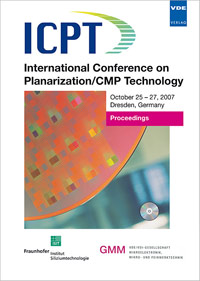Influence of Pad Structures on Slurry Performance for Cu CMP
Conference: ICPT 2007 - International Conference on Planarization / CMP Technology
10/25/2007 - 10/27/2007 at Dresden, Germany
Proceedings: ICPT 2007
Pages: 5Language: englishTyp: PDF
Personal VDE Members are entitled to a 10% discount on this title
Authors:
Li, Yuzhuo; Cheemalapathi, Krishnayya; Wang, Changxue (Center for Advanced Materials Processing (CAMP) Clarkson University, Potsdam, NY)
Tetsujiro, Tada; Arahata, Takashi; Kodaba, Ichiro; Watanabe, Jun (Mipox International Corporation, Hayward, CA)
Abstract:
As an essential consumable, polishing pads play a critical role in determining the outcome and manufacturing viability of a CMP process. An effective pad must have the right macro- and micro-structures in order to provide proper slurry transport, polishing debris management, and optimum hardness characteristics to maximize planarization efficiency and minimize defect counts. Such a balance is often accomplished by a deliberate match of groove dimensions, pore/cell distributions, and top/bottom stack layers with differential properties. In addition to the usual mechanical issues associated with the design and performance of a pad, the ability for a pad to host and handle the chemical components of slurry is equally important. For example, during copper polishing, the slurry trapped between the wafer and the pad can be significantly different from its original formulation. It is important to understand the impact of physical design and chemical properties of the pad on its ability to transport, host, and possibly react to the spent slurry. Unlike conventional porous pads, the focus of this study is on the non-cell type Mipox CMP pads. In this talk, a brief introduction to the Mipox non cell pads will be given. The performance of such pad in terms of material removal rate, within wafer non-uniformity, step height reduction efficiency, and surface quality for copper CMP is reported in comparison with conventional porous pads. The potential advantages of the non-porous pads such as lifetime will be discussed.


